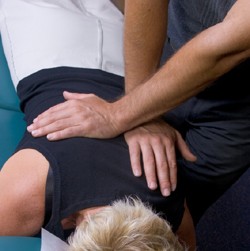What started as a routine day for John quickly turned into a painful ordeal. While walking down a flight of stairs, he missed a step and lost his balance, leading to a sudden fall. As he hit the ground, he felt a sharp, stabbing pain in his lower back. At first, he hoped the discomfort would fade, but the pain lingered and intensified with every movement.

John’s injury impacted his ability to perform daily activities. Simple tasks like bending to pick something up or even getting out of bed became agonizing. He noticed swelling around his lower back and occasional numbness down his legs. Realizing that this was more than just a mild bruise, John sought medical attention to assess the severity of the injury.

After visiting his doctor, John was diagnosed with a lumbar sprain, a common injury caused by overstretching or tearing of ligaments in the lower back. The physician explained that such injuries can take weeks to months to heal, depending on the care and rehabilitation process.
Rest and Ice: For the first 48 hours, John was advised to rest as much as possible and apply ice packs to reduce inflammation.
Pain Management: Over-the-counter pain relievers helped control the pain, but John was careful not to over-rely on them.
Physical Therapy: After the initial swelling subsided, John began a series of gentle stretching exercises to improve flexibility and strengthen his back muscles. These exercises were crucial in restoring mobility and preventing future injuries.
Lifestyle Adjustments: John learned the importance of proper posture, ergonomics, and lifting techniques to avoid straining his back during everyday activities.
Lessons Learned: How to Prevent Future Back Injuries
John’s experience taught him the importance of taking care of his back health. Here are some tips that helped him avoid further injury:
Lift with Your Legs, Not Your Back: When lifting heavy objects, always bend at the knees and use your leg muscles to take the strain off your back.
Practice Good Posture: Whether sitting or standing, maintaining a neutral spine position can help prevent strain on your back muscles.
Stay Active: Regular exercise strengthens core and back muscles, reducing the risk of injuries from sudden movements or falls.
John’s journey from a painful fall to full recovery wasn’t easy, but through persistence, medical advice, and proper rehabilitation, he regained his strength and mobility. If you or someone you know is dealing with back pain from a fall, remember that proper care and early intervention can make all the difference.
Our mission is to be Pittsburgh’s top center for chronic conditions, specializing in chiropractic care and functional medicine. We provide innovative, non-invasive treatments that address root causes, helping patients achieve lasting wellness.
© Copyright 2012 - 2024 | CHRONIC PA | ALL RIGHTS RESERVED